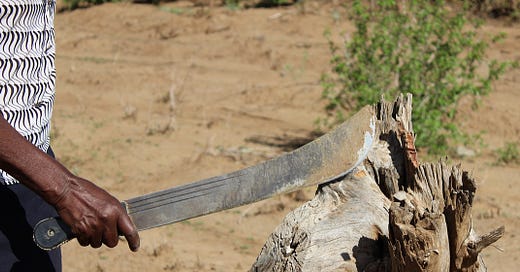After the invasion: restoring land vs. making a living
To mark World Environment Day, a case of tough trade-offs in Kenya 🌐
WorldWise readers—
Today’s post has a focus on the environment, taking its lead from the UN’s agenda.
We begin with a story to mark World Environment Day, which this year focuses on the theme of “land restoration, desertification and drought resilience”. A couple of years ago I visited Kenya’s Baringo county where scientists, farmers and community leaders are grappling with efforts to restore land lost to a robust invasive species—efforts which are coming against the long-standing tension between prioritising nature conservation vs. livelihoods. The excerpts published here are followed by a link to the full multimedia story and context around its commissioning.
We then move to a roundup of media analyses of recent negotiations towards the first globally binding treaty to limit plastic pollution, leading up to the usual Briefing sections.
Anita
VIEW EDITION | a global take on pressing issues for humanity
INSIGHT | views & analysis
A grim sight lay ahead.
It was nearing mid-day, the sun ablaze. We walked carefully past the goat pen, treading over thorny weeds.
Rispah Enenganai’s goat had perished earlier that morning. Her neighbour’s goat also died that day. And they knew the culprit all too well.
This is what happens to animals feeding on fruits from Prosopis juliflora, a shrub-tree species that grows everywhere in this part of Kenya and is known locally as mathenge.
The fruit is seductively sweet—so delicious, they can’t get enough. But feasting on it sets off a deadly chain of events.
…
Prosopis has been gaining ground in East Africa for decades, and its territory is still expanding at pace.
It comes with a long list of problems that aren’t limited to fatally sweet fruit.
The branches of P. juliflora trees are full of large sharp thorns that injure farmers as they go about managing their land. The spikes deform fish in nearby Lake Baringo, damage fishing nets, and puncture vehicle tyres.
A shrubby tree, this Prosopis species spreads out so thick that waterways, roads and trails become difficult to access. Along the way, vast quantities of water are sucked up from the ground, aggravating impacts of climate change in this dryland area.
Once the invasive species takes hold, it’s very hard to get rid of it.
Stuck with the omnipresent tree, people in this part of Kenya often try to reap some benefits. The wood can be burnt for fuel. It’s used as a building material, to build fences for example. And it’s burnt to make charcoal. Even so, surveys suggest that most residents of Baringo believe they would be better off without Prosopis.
Il Chamus and Tugen are two ethnic groups facing a common enemy in the invasive species. The area being gobbled up by P. juliflora in this part of Baringo country is made up of mostly communal land. It is home to several pastoral groups which then end up competing for resources, moving ever closer to the edge of their respective territories.
The amount of land taken over in this region spiked by more than 2000% over nearly 30 years, making Baringo county one of the most heavily invaded areas of eastern Africa. Researchers estimate that, left unchecked, 80% of land in this part of Baringo will be lost to Prosopis in coming years.
One prong of the control strategy—charcoal production—has become an important source of income for local communities.
It took off some 15 years ago, after a policy came in to encourage use of Prosopis to make charcoal in Baringo. The idea was to fight back against spread of the shrub by tapping into the economic benefit of selling charcoal. Could production use up enough of the woody species to make a difference?
It’s a case of tough trade-offs.
Baringo residents already affected by Prosopis know they have no choice but to live with it. But using up the wood isn’t enough to curb the spread.
Can local farmers take the pain of losing income in the short-term to beat back the hardy invader in the long-term?—Read the full story on the R4D website*
*WARNING: includes video with scenes that may be disturbing to some viewers
—
📌 This story was commissioned by r4d, a Swiss programme which over the course of a decade has supported research for development projects around the world. I’ve been working as an editorial/comms consultant for the programme as part of my work alongside journalism, supporting selected development/research/media organisations with compatible values.
A joint initiative by the Swiss Agency for Development and Cooperation and the Swiss National Science Foundation SNSF, r4d was funded with roughly CHF 100 million between 2012 and 2023, and recognised by external evaluators as a pioneer in its approach.
In collaboration with talented associates we produced more than a dozen articles about the projects, designed and delivered trainings, produced audiovisual stories, began a process of strategic media engagement, and pulled together this synthesis of r4d’s achievements and impact.
BRIEFING | around the world
Spotlight on: UN plastics treaty
Two years after the UN Environment Assembly adopted a resolution to develop a globally binding treaty to limit plastic pollution, the process remains fraught with disagreements. The wrangling is mostly about restricting production of plastics, a key aim of the treaty alongside improving the management of plastic waste.
With the first-ever agreement still due to be completed this year, the fourth round of negotiations took place in Canada in April, and the final process meeting is planned for December in Korea.
Emma Bryce lays out five key takeaways from Ottawa in a piece for Dialogue Earth—highlighting the proliferation of over 3000 (!) brackets in the draft treaty text, which indicates disagreement over multiple sections and calls into question the prospect of deciding by consensus.
In a briefing for World Politics Review, Joshua Lincoln makes the case that reaching agreement on this treaty matters for climate action too. That’s because production of primary plastics is estimated to account for about a fifth of the world’s carbon budget by 2050.
The point is echoed in a comment by Martha Molfetas for Global Policy Journal. “There are some pretty big voices pushing for continued use of plastics”, she writes.
On that note: Stéphanie Fillion reports for Devex that 196 lobbyists were registered for the meeting in Ottawa, outnumbering the countries attending the talks.
As a ‘Plan B’ for their bottom line, fossil fuel companies are planning to triple plastics production in coming decades while the world reduces consumption of oil, gas, and coal, Joseph Winters reports for Grist.
In an editorial, The Lancet’s editors outline the health hazards that come with the environmental pollution caused by production and use of plastics. They also acknowledge how indispensable these materials have become, noting modern medicine’s reliance on plastic tools like intravenous tubes, syringes and catheters. The editorial concludes by quoting Inger Andersen, the UN Environment Programme Executive Director, on what the big-picture goal should be: to “live with plastic and not be doomed by it”.
News highlights
Global food production and small-scale farmers are under threat from ‘green grabbing’. Land prices around the world have doubled since 2008, with 20% of large deals linked to carbon offsets, conservation or clean energy projects—read the details in a report by the International Panel of Experts on Sustainable Food Systems.
There’s a problem with the growing market value of forests. Trees are in demand for their ability to capture carbon and counteract climate change, but carbon offset projects (some with questionable benefits) are displacing people that depend on forests for food and income—Kate Yoder reports for Grist.
The Bezos Earth Fund has become one of the most influential voices in the climate and biodiversity sector. While dozens of NGOs and related initiatives benefit from multimillion-dollar grants, experts voice unease over conflicts of interest and ‘greenwashing’—Patrick Greenfield reports for the Guardian.
An official system is being set up to challenge carbon credit developers. At a recent meeting on implementing the Paris Agreement, government negotiators and experts approved a procedure that will allow local communities to officially challenge UN-registered carbon credit projects—Joe Lo reports for Climate Home News.
In Ecuador, a year on from one of the largest debt-for-nature swap deals, there’s little to show on progress. A Latin American NGO has found “no evidence that the country has operating procedures in place to allocate funds or guide investment” into the Hermandad Marine Reserve. Alejandra Padin-Dujon reports for Carbon Pulse.
The lack of implementation is echoed by Katie Surma in a story for Inside Climate News, reporting on Ecuador’s failure to enforce legal judgments that grant nature rights to protection similar to those of people.
Under the radar
The Amazon on fire: Brazil's Amazon rainforest has seen its largest fires on record in the first four months of this year, following an intense drought which has contributed to dry conditions that fuel the blazes. Environmental workers point the finger at reduced funds for firefighting under President ‘Lula’ Luiz Inácio Lula da Silva, who has vowed to protect the rainforest region—Jake Spring reports for Reuters.
Forced out by the harsh climate of the Himalayas: Moving is the norm for the nomadic pastoralists in the village of Samdzong, along the borden between Nepal and Tibet, 4,100 metres above sea level. Now, the region is considered ‘ground zero’ for climate impacts, and a prolonged drought forced the residents into a new wrenching decision: whether to stay or leave—Tulsi Rauniyar reports for BBC Future.
Seeking Solutions
Vanuatu is cyclone-proofing its food systems: As natural disasters increase threefold in the Pacific, one of the world’s most disaster-prone regions, the government of Vanuatu is working with NGOs to protect its food systems using a combination of new technology and traditional techniques—Rebecca L. Root reports for Devex.
How bioengineering saved a Himalayan road from floods: In parts of north India vulnerable to landslides, the usual practice of building 10-feet high concrete walls to protect roads during intense rains still leaves exposed slopes at risk. But bioengineering techniques introduced in 2010 saved parts of the region from a deadly landslide in August of 2023—Charu Bahri reports for Dialogue Earth.
Culture Corner
“Historically the Northeast, more than two thirds of whose inhabitants are of African descent, has been the poorest part of the country, dominated by a small class of lighter-skinned landowners and political bosses known as “colonels” in part because of their control of state militias. … It is this system of exploitation—and the continuing violence it engenders in order to maintain itself—that has both appalled and enthralled Brazilian novelists, playwrights, poets, filmmakers, painters, and photographers in the modern era.” — Larry Rohter, ‘In the Heart of Bahia’, for The New York Review
HOUSEKEEPING NOTE
This newsletter comes in two editions, both focused on interconnected and pressing issues for humanity—development, health, environment, human rights.
📢 This is the last VIEW edition before WorldWise takes its usual break over the Northern hemisphere summer—this time, expect the occasional dispatch while we recharge our batteries and plan ahead for a new season.
🤍 A big thank you to those of you who continue to support my time and energy for the project through a subscription (you can do that here).
MEDIA | working communications
ICYMI—If you’ve ever struggled with the notion of “making a difference” through your work, check out the last MEDIA edition for a few thoughts inspired by the view from the career pinnacle of some celebrated war photographers.
Also includes the latest global media opportunities (fellowships, grants, trainings, awards, etc.) + what editors wish freelancers knew. For more opportunities, follow WorldWise on LinkedIn.







